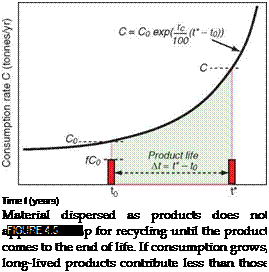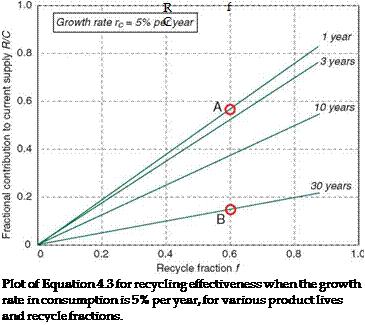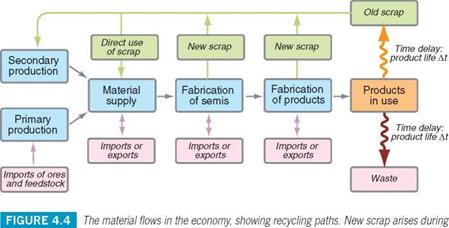Of the five end-of-life options shown in Figure 4.1, only one meets the essential criteria that:
■ It can return waste materials into the supply chain
■ It can do so at a rate that, potentially, is comparable with that at which the waste is generated
Landfill and combustion fail to meet the first, and refurbishment and reuse, almost always, fail the second. That leaves recycling (see Figure 4.2).
Quantification of the process of material recycling is difficult. Recycling costs energy, and this energy carries its burden of gases. But the recycle energy is generally small compared to the initial embodied energy, making recycling—when it is possible at all—an energy-efficient proposition. It might not, however, be one that is cost efficient; that depends on the degree to which the material has become dispersed. In-house scrap, generated at the point of production or manufacture, is localized and is already recycled efficiently (near 100% recovery). Widely distributed "scrap"—material contained in discarded products—is a much more expensive proposition to collect, separate, and clean. Many materials cannot be recycled, although they may still be reused in a lower-grade activity; continuous-fiber composites, for instance, cannot be reseparated economically into fiber and polymer to reuse them, though they can be chopped and used as fillers. Most other materials require an input of virgin material to avoid buildup of uncontrollable impurities. Thus the fraction of a material production that can ultimately reenter the cycle of Figure 4.1 depends on both the material itself and the product into which it has been incorporated.
Metals. The recycling of metals in the waste stream is highly developed. Metals differ greatly in their density, in their magnetic and electrical properties, and even in their color, making separation comparatively easy. The value of metals, per kilogram, is greater than that of other materials. All these factors help make metal recycling economically attractive. There are many limitations on how recycled metals are used, but there are enough good uses that the contribution of recycling to today’s consumption is large.
Polymers. The same cannot be said of polymers. Commodity polymers are used in large quantities, many in products with short life, and they present major problems in waste management, all of which, you would think, would encourage effective recycling. But polymers all have nearly the same density, have no significant magnetic or electrical signature, and can take on any color that the manufacturer likes to give them. They can be identified by X-ray fluorescence or infrared spectroscopy, but these methods are not infallible and they are expensive. Many are blends and contain fillers or fibers. The recycling process itself involves a large number of energy-consuming steps. Unavoidable contamination can prevent the use of recycled polymers in the product from which they were derived, restricting them to more limited use. For these reasons, the value of recycled polymers—the price at which they can be sold—is typically about 60% of that of virgin material.
A consequence of this situation is that the recycling of many commodity polymers is low. Increasing the recycle fraction is a question of identification, and here there is progress. Figure 4.3 shows, in the top row, the standard recycle marks, ineffective because they do not tell the whole story. The lower row shows the emerging identification system. Here polymer, filler, and weight fraction are all identified. The string, built up from the abbreviations listed in the appendix to this chapter, give enough information for effective recycling.
The economics of recycling. Although recycling has far-reaching environmental and social benefits, it is market forces that—until recently— determined whether or not recycling happened. Municipalities collect recyclable waste, selling it through brokers to secondary processors who reprocess the materials and sell them, at a profit, to manufacturers. The recycling market is like any other, with prices that fluctuate according to the balance of supply and demand. In a free market, the materials that are recycled are those from which a profit can be made. These include almost all metals but few polymers (see Table 4.1).
Scrap arises in more than one way. New or primary scrap is the cutoffs from billets, risers from castings, and turnings from machining that are a by-product of the manufacture of products; it can be recycled immediately, often in-house. Old or secondary scrap appears when the products
/X
> PC-ABS-FR <
![]()
 |
Top: recycle marks for the most commonly used commodity polymers. Bottom: more explicit recycle marks detailing blending, fillers and reinforcement. The first is polypropylene 20% talc powder. The second is a polycarbonate/ABS blend with glass fiber. The coding is explained in the appendix to this chapter.
|
Table 4.1 Recycling markets |
||
|
Material family |
Developed end uses for recycled materials |
Existing secondary uses but not developed as a market |
|
Metals |
Steel and cast iron Aluminum Copper Lead Titanium All precious metals |
Paper—metal foil packaging |
|
Polymers and elastomers |
Polyethyleneterephthalate (PET) High-density polyethylene (HDPE) Polypropylene (PP) Polyvinylchloride (PVC) |
All other polymers and elastomers, notably tires |
|
Ceramics and glasses |
Bottle glass Brick Concrete and asphalt |
Nonbottle glass |
|
Other materials |
Cardboard, paper, newsprint |
Wood Textiles: cotton, wool, and other fibers |
themselves reach the end of their useful lives (see Figure 4.4). The value of recyclable waste depends on its origin. New scrap carries the highest value because it is uncontaminated and easy to collect and reprocess. Old scrap from commercial sources such as offices and restaurants is more valuable than that from households because it is more homogeneous and needs less sorting.
|
manufacture and is reprocessed almost immediately. Old scrap derives from products at end of life; it reenters production only after a delay of At, the product life. |
Producers of secondary materials must, of course, compete with those producing virgin materials. It is this fact that couples the price of the first to that of the second. Virgin materials are more expensive than those that have been recycled, because their quality, both in engineering terms and that of perception, is greater. Manufacturers using recycled materials require assurance that this drop in quality will not compromise their products.
The profitability of a market can be changed by economic intervention— subsidies, for instance, or legislation with penalties for failure to comply. Legislation setting a required level of recycling of vehicles and of electronic products at the end of their lives is now in force in Europe; other nations have similar programs and plans for more. Municipalities, too, have recycling laws requiring the reprocessing of waste that, under free-market conditions, would have zero value. In a free market these products would end up in landfill, but the law prohibits it. When this is so, municipalities sell the materials for a negative price—that is, they pay processing firms to take them. The negative price, too, fluctuates according to market forces and may, if technology improves or demand increases, turn positive, removing the need for the subsidy.
Where laws requiring recycling do not exist, recycling must compete also with landfill. Landfill, too, carries a cost. What is recycled and what is dumped then changes as market conditions—the level of a landfill tax, for instance— change and businesses seek to minimize the cost of managing waste.
All this could give the impression that waste management is a local issue, driven by local or national market forces. But the insatiable appetite
![]()
 |
of the fast-developing nations, particularly China and India, turn the "waste" of Europe and the United States into what, for these developing countries, is a resource. Low labor costs, sometimes less restrictive environmental regulation, and different manufacturing quality standards drive a world market in both waste and recycled materials.
The contribution of recycling to current supply. Suppose that a fraction f of the material of a product with a life of At becomes available as old scrap. Its contribution to today’s supply is the fraction / of the consumption At years ago. Material consumption, generally, grows with time, so this delay between consumption and availability as scrap reduces the contribution it makes to the supply of today.
Figure 4.5 illustrates this idea. Suppose, for the moment, that a material exists that is used for one purpose only in a product with a life span At and that, at end of life, a fraction f (about 0.6 in the Figure) is recycled into supply for current consumption, which has been growing at a rate rc % per year. If the consumption rate when the product was made at time t0 was C0 tonnes per year, the consumption today, at time t*, is:
C = C0exp( Г (t* – t0)) = C0exp( Г At) (4.1)
0 100 0 0 100 1 !
where At = t* – t0. The recovered fraction is:
FIGURE 4.6
 |
|
shown as a red bar on the Figure. Its fractional contribution to supply today is:
Figure 4.6 shows what this looks like for a product with a growth rate of 5% per year. If the fraction f = 0.6 and the product life At is one year, the contribution is large, about 0.58 of current supply (Point A on Figure 4.6). But if the product life is 30 years, the contribution falls to 0.17 (Point B). The recycle contribution increases with f, of course. But it decreases quickly if the product has a long life or a fast growth rate.
In reality most materials are used in many products, each with its own life span Ati, recycle fraction f, and growth rate rci. Consider one of these— product "i"—that accounts for a fraction s1 of the total consumption of the material. Its fractional contribution to consumption today is:
![]() (4.4)
(4.4)
exp(-c,~ At1) 100 11
The total contribution of recycling is the sum of terms like this for the material in all the products that use it.
An example will bring out some of the features. A material is used to make both gizmos and widgets; each accounts for 25% of the total consumption of the material. Gizmos last for 20 years; their sales have grown steadily at 10% per year. At the end of life, gizmos are dismantled and all the material is recovered f gizmo = 1). Widgets, on the other hand, have an average life of four weeks and are difficult to collect; their recycle fraction is only fwidget = 0.5. Their sales have grown slowly, at 1% per year for the recent past. Inserting these data into Equation 4.4, we find an unexpected result: Gizmos, all of which are recycled, contribute the tiny fraction of 0.03 to current supply, whereas widgets, only half of which are recycled, contribute a much larger fraction of 0.125. The main effect here is the product lifetime: products with short lives make larger contributions to recycling than those that last for a long time. This reveals one of the many unexpected aspects of the materials economy: making products that last longer can reduce demand, but it also reduces the scrap available for recycling. If, in making products last longer, they have to be made more robust, meaning that they use more material, the effect can even be to increase the demand for primary materials.
4.2 Summary and conclusion
The greater the number of us that consume and the greater the rate at which we do so, the greater is the volume of materials that our industrial system ingests and then ejects as waste. Real waste is a problem—a loss of resources that cannot be replaced, and there has to be somewhere to put it and that, too, is a diminishing resource.
But waste can be seen differently: as a resource. It contains energy and it contains materials, and—since most products still work when they reach the end of their first life—it contains components or products that are still useful. There are a number of options for treating a product at the end of its first life: extract the energy via combustion, extract the materials and reprocess them, replace the bits that are worn, and sell it again, or, more simply, put it on eBay or another trading system and sell it as is.
All these options have merit. But only one—recycling—can begin to cope with the volume of waste that we generate and transform it into a useful resource.
4.3 Further reading
Chapman, P. F. and Roberts, F. (1983), "Metal resources and energy, Butterworth’s Monographs in Materials", Butterworth and Co., ISBN 0-408-10801-0. (A monograph that analyzes resource issues, with particular focus on energy and metals.)
Chen, R. W., Navin-Chandra, D. Prinz, F. B. (1993), "Product design for recyclability: a cost/benefit analysis". Proceedings of the IEEE International Symposium on Electronics and the Environment, Vol. 10-12, 178-183, ISEE.1993.302813.
(Recycling lends itself to mathematical modeling. Examples can be found in the book by Chapman and Roberts, above, and in this paper, which takes a cost – benefit approach.)
Guidice, F., La Rosa, G. and Risitano, A. (2006), "Product design for the environment", CRC/Taylor and Francis, ISBN 0-8493-2722-9. (A well-balanced review of current thinking on eco-design.)
Henstock, M. E. (1998), "Design for recyclability", Institute of Metals. (A useful source of background reading on recycling.)




